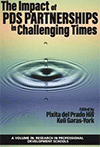
The Impact of PDS Partnerships in Challenging Times
Edited by:
Pixita del Prado Hill, SUNY Buffalo State
Keli Garas-York, SUNY Buffalo State
A volume in the series: Research in Professional Development Schools and School-University Partnerships. Editor(s): JoAnne Ferrara, Manhattanville College. Ronald Beebe, University of Houston -Downtown. Drew Polly, UNC Charlotte. Jennifer K. McCorvey, University of South Florida.
Published 2021
The Impact of PDS Partnerships in Challenging Times is the follow up to Doing PDS: Stories and Strategies from Successful Clinically Rich Practice (2018). The first book included stories that described our experiences across more than twenty-five years of PDS partnerships. We sought to examine and chronicle the innovative ways we negotiate school-university collaboration while explaining the development of the SUNY Buffalo State PDS consortium. This second volume strives to explore the impact of our endeavors individually at each school/community site and collectively as an entire consortium to point to the important ways that school-university partnership contributes to all stakeholders and where we might do better.
SUNY Buffalo State’s PDS roots go back to 1991 with one local school partner. Today this school-university partnership consortium connects with over 100 schools with approximately 45 signed agreements each semester in Western New York, nationally, and internationally. The SUNY Buffalo State PDS consortium is grounded in three frameworks for clinically rich practice: (a) the National Association for Professional Development Schools Nine Essentials (Brindley, Field, & Lesson, 2008); (b) CAEP Standards for Excellence in Educator Preparation, Standard 2 (http://caepnet.org/standards/standard-2, 2018); and (c) the Buffalo State Teacher Education Unit Conceptual Framework (https://epp.buffalostate.edu/conceptualframework, 2018).
Through specific examples, each chapter utilizes a case study approach to describe the nature of various partnerships situated in research with a focus on the impact of the partnership. The chapters are intentionally succinct to provide a focused look at a particular partnership activity as each contributes to the larger goals of the entire consortium. Every chapter follows a similar structure – defining a challenge identified by the members of the consortium, a review of the relevant literature, an explanation of how the school/community liaison team responded to the challenge and the data gathered to determine impact, an “impact at a glance” chart to report the findings, and an identification of the necessary next steps in the project.
CONTENTS
Acknowledgments. Series Foreword, JoAnne Ferrara and Janice Nath, Research in Professional Development Schools Series Editors. Foreword, Wendy Paterson. Introduction: Reframing Impact Within the PDS Context, Pixita del Prado Hill and Keli Garas-York. PART I: THE IMPACT OF MUTUALLY BENEFICIAL PDS PARTNERSHIPS. A Framework for Collaborative Research with PDS: Using Kagan Cooperative Learning Structures to Meet All Students’ Needs, Tim Zgliczynski, Larry Maheady, and Patricia D. George. Strengthening Community Relationships with a Symbiotic PDS Partnership, Christopher Shively and Jill Clark. A Partnership Response to the Substitute Teaching Shortage, James Maloney, Sue McMillen, and Matthew Jay Hahn. PART II: THE IMPACT OF INTERDISCIPLINARY PDS PARTNERSHIPS. Collaborative Curriculum Development to Prepare Candidates Certified in Both General and Special Education, Lisa A. Rafferty, Angela L. Patti, and David Henry. Using Co-Teaching to Develop 21st Century Literacies in Secondary Teachers, Sue McMillen and Pixita del Prado Hill. Interdisciplinary Cohorts for Secondary Teacher Preparation, Sue McMillen and Jodelle S. W. Magner. Implementing a Peer Teaching Model to Develop Professional Skills for Working with Young Children at Diverse PDS Sites, Pamela Schuetze and Kathy R. Doody. Transdisciplinary Collaborations: Relying on Colleagues with Various Expertise to Benefit Teaching Pedagogy and the Student Experience, Katrina Fulcher, Pamela Schuetze, and Kathy R. Doody. PART III: THE IMPACT OF GLOBAL PDS PARTNERSHIPS. Singing Their Way Through Teaching English: Experiences of Teacher Candidates at an Italian Elementary School, Kerry B. Renzoni, Maria Ceprano, and Mary Shea. A Multicultural Journey Through Literature: The Chilean Experience, Emilio Araya, Rosa Delicio, Miquéias Rodrigues, and Lorena Soto. PART IV: THE IMPACT OF VIRTUAL PDS PARTNERSHIPS. A Virtual School-University Partnership: IPDS Honduras, Sue McMillen and Beth McMillen. Technology-Based Simulation to Prepare Special Education Teachers, Dennis Garland and Krista Vince Garland. The Global Literacy Channel: Teaching Readers and Writers around the Globe, Patricia D. George and Rachel Nati. PART V: THE IMPACT OF SERVICE-LEARNING PDS PARTNERSHIPS. Family Fun Night: An Event for Children, Families, and Teacher Candidates, Kathy R. Doody and Patricia D. George. The Relationship Between Service-Learning and Field Experience in the Context of PDS, Julie Henry and Renee Carr. PDS, Families, and STREAM: Oh My! Dianne McCarthy and Elizabeth Eden. PART VI: THE IMPACT OF LEADERSHIP DEVELOPMENT THROUGH PDS PARTNERSHIPS. Growing Our Own in Buffalo Through the Urban Teacher Academy, Kathy L. Wood and William Keresztes. Structures that Promote Self-Confidence in PDS Undergraduate Student Representatives, Sherri Weber and Daniel Klein. Building a Better Math Teacher: Community Learning in a PDS, David C. Wilson and Jessica N. McGill. PDS and a School District Partner Develop Leadership Together, Thomas McCully and Gretchen Cercone. Conclusion: How PDS Partnerships Make Meaningful Impact Possible, Pixita del Prado Hill, Larry Maheady, Julie Henry, and Keli Garas-York. Biographies.
-
Paperback978-1-64802-189-3
Web price: $45.04 (Reg. 52.99)
-
Hardcover978-1-64802-190-9
Web price: $80.74 (Reg. 94.99)
- eBook978-1-64802-191-6

- EDU046000 - EDUCATION: Professional Development
- EDU029040 - EDUCATION: TEACHING METHODS & MATERIALS: Social Science
- EDU053000 - EDUCATION: Training & Certification
-
 A Pathway to PDS Partnership
Using the PDSEA Protocol
A Pathway to PDS Partnership
Using the PDSEA Protocol
-
 A Practical Guide to Exemplary Professional Development Schools
A Practical Guide to Exemplary Professional Development Schools
-
 Clinically Based Teacher Education in Action
Cases from Professional Development Schools
Clinically Based Teacher Education in Action
Cases from Professional Development Schools
-
 Doing PDS
Stories and Strategies from Successful Clinically Rich Practice
Doing PDS
Stories and Strategies from Successful Clinically Rich Practice
-
 Exploring Cultural Competence in Professional Development Schools
Exploring Cultural Competence in Professional Development Schools
-
 PDS and Community Schools
The Nexus of Practice
PDS and Community Schools
The Nexus of Practice
-
 Visions from Professional Development School Partners
Connecting Professional Development and Clinical Practice
Visions from Professional Development School Partners
Connecting Professional Development and Clinical Practice

